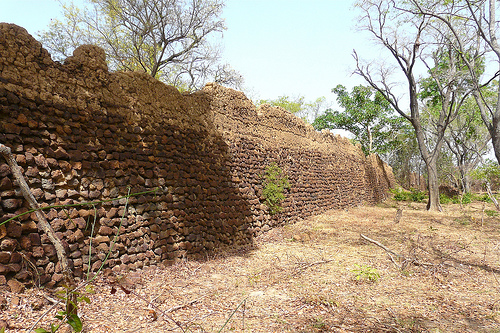

Location: West of Gaoua Map
Area: 11,130m2
Loropéni is located West of Gaoua in South West Burkina Faso. This archeological site covers an area of 11,130 sq meters.
The history of the Loropéni Archaeological Site is somewhat sketchy.
Loropeni was constructed before the arrival of the Europeans
travellers and traders. It was inhabited by tribes of Lohron or
Koulango and probably served as a palace for king Kaan lya of the
Kaan people. Legend claims that Kaan lya constructed his citadel to
protect his life and life of his subjects. He died shortly
thereafter and future kings abandoned Loropeni as their capital. It
was settled by the local people as a walled city.
This
settlement of Loropéni was surrounded by massive walls for at least
1000 years. It gained it peak power in the 14th- 17th centuries due
to gold trade. However the trade eventually ceased and the site was
eventually abandoned by the 19th century. The site was added to
UNESCO World Heritage List and today it is being uncovered by
international archaeological teams.
The monumental complex was inscribed on the list
of World Heritage properties in 2009 , with an extension of 1.1130
ha and a protection area of 278.4000 ha. It is Burkina Faso's
first place to achieve that honor.
It is the best preserved
of the ten fortresses that the region has, located in the region
with Togo and Ghana . Built over a thousand years ago, abandoned and
reoccupied by the Lohron or Koulango that controlled the extraction
and transformation of gold in the region, at its peak, from the 14th
to the 16th centuries . They were abandoned in the 19th century .
These are walls of red stone blocks, without carving, and
laterite morrillos that rise up to six meters high. There is no
certainty as to its builder.
Le rovine di Loropéni is an archaeological
site located in the same department of Burkina Faso. Since 2009 the site
is even a UNESCO World Heritage Site for its cultural value (the richest
of the inseriment was presented on 9 March 2009).
The UNESCO World Heritage Site of 1,113 is located in the Lobi area, not
close to the border of Burkina Faso with Cote d'Ivoire, Ghana and Togo.
The roof lies in the remains of the wall in stone of an imposing
fortress that dates back to the late I millennium AD. and I testify to
the presence of a fiorent civiltà, probably connessa to the
trans-Saharan trade in gold. Here the wall consists of the most
preserved part of a larger complex that included another 9 forts and
about a century of smaller structures in the wall.
This area,
between the 14th and 17th centuries, was inhabited by gold-mining and
gold-mining populations, Koulango and Lokron. Good part is still
scavare.